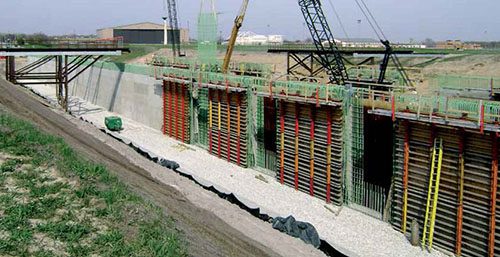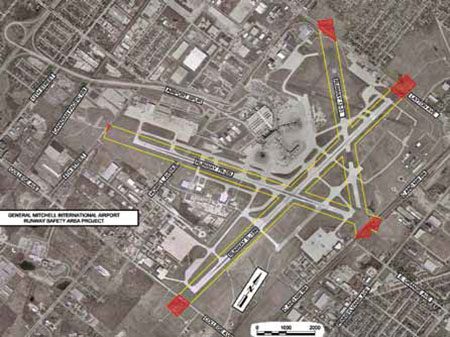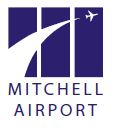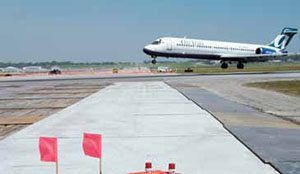 Milwaukee's General Mitchell International Airport (MKE) undoubtedly gained favor with the FAA in August, when it completed a seven-year, $70 million series of runway safety area (RSA) projects three years ahead of a congressional deadline.
Milwaukee's General Mitchell International Airport (MKE) undoubtedly gained favor with the FAA in August, when it completed a seven-year, $70 million series of runway safety area (RSA) projects three years ahead of a congressional deadline.
|
factsfigures Project: Runway Safety Area Improvements Location: Gen. Mitchell Int'l Airport, Milwaukee Cost: $70 million Construction Value: $55 million Timeline: 2005-2012
Planning, Design, Environmental 6th St. Relocation: Edgerton Contractors
Taxiways M & N Reconfiguration: Bypass Road: Edgerton Contractors College Ave. Tunnel Structure: Lunda Construction Runway 7R-25L RSA Improvements: Super Western
Runway 1L-19R RSA Improvements: Excavation: More than 1 million cubic yards Concrete: 130,000+ cubic yards Electric Cable: 50+ miles |
The airport improved both of its commercial runways to meet FAA standards requiring 500-foot wide, 1,000-foot long safety areas at each end. Its shorter runway, 13-31, was simply reclassified into a lower design group, which meant its existing RSAs were up to standard and rendered additional construction unnecessary.
MKE's recently completed projects are one more signpost in the  evolution of FAA's formal RSA program, which was established in 1999 after a fatal overrun at Little Rock Airport in Arkansas.
evolution of FAA's formal RSA program, which was established in 1999 after a fatal overrun at Little Rock Airport in Arkansas.
A Department of Transportation audit completed in 2008 further highlighted the need for RSA improvements. It found that 75 aircraft overran or veered off U.S. runways, resulting in nearly 200 injuries and 12 fatalities, from 1997 to 2007. In 2005, Congress mandated that all RSAs not meeting FAA standards be improved by 2015. By 2008, more than 70% of "priority RSAs" had been improved.
While RSA projects at some airports were relatively simple, MKE's improvements were more complex. Nearby railroad tracks and city streets ultimately required one runway threshold to be changed, and a tunnel was constructed to help remedy the other. Jim Zsebe, the airport's project manager, acknowledges that it's difficult to capture the airport's intricate, multi-faceted plan on paper, given all the elements and details it included.
Environmental and feasibility studies performed by Mead & Hunt  identified more than 30 alternatives for the airport's new RSAs. Dovetailing work on four runway ends with other construction projects required careful planning and phasing, recalls Laura Morland, environmental practice leader for Aviation Services at Mead & Hunt.
identified more than 30 alternatives for the airport's new RSAs. Dovetailing work on four runway ends with other construction projects required careful planning and phasing, recalls Laura Morland, environmental practice leader for Aviation Services at Mead & Hunt.
Zsebe credits open communication between key players for the project's smooth progress throughout four construction seasons. Monthly project planning calls began in fall 2008 and ran through late August 2012. Determining the optimum order of construction was a particular challenge, requiring input from airport engineers, operations personnel, Mead & Hunt and contractors, he adds.
Round 1
MKE's 8,000-foot Runway 7R-25L was constrained in both key directions – to the west by a city street and to the east by an active railroad line. Shifting the Runway 25L safety area 540 feet to the west emerged as best way to avoid the railroad tracks. To do so, crews removed the existing 540 feet of pavement, reconfigured taxiways and added the same amount of pavement to the 7R end. This subsequently required the city street on the west side to be moved.
Throughout the multi-phase RSA project, the 7R threshold was the only one to be relocated. It, however, required a new instrument approach, the relocation of lighting/guidance systems and the 25L localizer, and installation of new high-intensity runway lights and infrastructure for future in-pavement centerline lead-in lighting for 7R in addition to runway guard lights.
Developing a new approach procedure for arriving aircraft took 18 months.
The Runway 7R-25L RSA upgrades repeatedly tested the flexibility of the team designing and implementing the multi-year project. Early in the planning phase, an issue surfaced at Taxiway M and the ends of 25L and 13-31. "They all converged into one configuration that the FAA wants to get away from," explains Greg Stern, a Mead & Hunt engineer.
and the ends of 25L and 13-31. "They all converged into one configuration that the FAA wants to get away from," explains Greg Stern, a Mead & Hunt engineer.
Although it wasn't part of the team's initial project, the issue became a primary focus when the FAA identified it as a hot spot. MKE was concerned about planes becoming too close on the runway while another aircraft was on approach.
"On that 25L end, we essentially killed two birds with one stone," Stern explains. "We cut off a section of the runway to pull the safety area from the railroad, but also reconfigured those taxiways to eliminate the convergence."
Ultimately, the change improved the airport's master plan, he notes.
 Round 2
Round 2
Changes to MKE's nearly 9,700-foot north/south runway – 1L-19R – were also complex. Here, the RSA extends over another city street (College Avenue), thanks to a new 640-foot-long tunnel off the south approach end. The project also required a 300-foot expansion of 1L and its parallel taxiway, as well as adjustments to approach lighting. The only improvement needed for the north end at 19R was relocating the airport's service road.
With most of the work occurring at the south end, away from the main terminal, corporate tenants were the customers most affected by the project, recalls Airport Operations Manager Kathleen David. A temporary taxiway was built to create new access to their hangars.
The southern project alone required major coordination, because Milwaukee County was already working to widen the nearby bustling College Avenue from two to four lanes. "This was an exercise in timing," recalls Zsebe. "There was nothing I could do about that project's schedule; we had to try and match it the best we could."
A temporary bypass was built for non-airport traffic during construction of the tunnel in 2010. When the county began its work, the road was closed completely. Coinciding timelines for funding from two different sources for two different projects on the same road was a particular challenge, recalls Zsebe. "We couldn't just tell them (the FAA) that the highway got delayed and we needed to wait; it doesn't work that way," he explains.
The design team engineered a cantilevered steel structure to keep runway lights in position, so the low-visibility runway could remain active during the tunnel construction.
"The contractor was able to build the tunnel, while keeping all the approach lights and all facilities for that runway in operation," says Stern. "I think that was something everyone was really glad we could accommodate."
Coordination Test
Given strict regulations regarding paved and turf surfaces, David considers airport "advisory requirements" a misnomer. "Those are the rules," she counters, noting that RSA projects consequently require extra vigilance from operations personnel.
MKE listed such requirements in its bid forms, so contractors knew up front what was expected and why, notes Zsebe. The Operations Department's experience with construction projects helped ensure adherence to Part 139 standards, he adds.
Despite precautionary measures, the airport still experienced a learning curve at the beginning of the RSA upgrades. MKE created a contractor safety video and required each worker to view it before receiving their access credentials. "I think it gives them a bigger picture," explains David, who was instrumental in developing the video's content. In addition to contrasting MKE's projects  with roadwork, the video explains regulatory requirements and other reasons why the airport must maintain such high standards.
with roadwork, the video explains regulatory requirements and other reasons why the airport must maintain such high standards.
Monitoring contractor practices, she emphasizes, was time well spent for the airport operations staff because it saved a lot of headaches and money.
Coordination with the air traffic control tower was also essential to the project, David adds. With only one active commercial runway, traffic was occasionally disrupted by unusual circumstances. "We did our best to expedite everything, and they did their best to keep everyone safe," she summarizes.
|
INNOVATION AT THE INTERSECTION
For years, the airport dealt with asphalt maintenance issues where runways 7-25 and 1-19 crossed. Patching and sealing alone were costing more than $100,000 per year. A study completed by Michael Baker Jr. Inc. concluded that a weak layer of asphalt eight inches below the surface was causing most of the problems. Although the vast majority of the runways are concrete, their intersection and several hundred feet around it were asphalt.
Occasional runway closures didn't allow crews enough time to remove the asphalt and replace it with concrete. Brisk aircraft traffic from commercial carriers and large cargo operations such as FedEx and UPS further complicated the scheduling issue.
Rich Teilborg, manager of ATC Systems in Southwest Airlines' Flight Operations Group, stresses the importance of successful and timely completion of such work. "(Personnel) who plan our flight schedules need at least a nine-month lead on runway closures to re-schedule flights in a way that impacts the fewest number of customers," Teilborg explains. The Fix MKE's intersection renovation was scheduled in two phases that spanned two years and corresponded with runway closures for runway safety area construction. When Runway 7R-25L was closed for safety area improvements in 2011, crews removed asphalt and placed concrete on the runway directly up to the intersection area known as "the bullseye." In 2012, the other runway, 1L-19R, was paved in similar fashion.
The larger issue, however, was that the concrete needed to be strong enough to support aircraft during an emergency. Christopher Decker, an engineer with airport paver Roy D. McQueen and Associates, developed a concrete mix to support an aircraft just two hours after pouring. Given the extreme weight that's concentrated on aircraft tires, 400 to 450 psi was needed and provided by the special mix, notes MKE Project Manager Paul Montalto. Terry Blue, MKE's deputy airport director of Operations and Maintenance, says that this group was integral in selecting the optimal solution and determining why solutions applied at other airports wouldn't necessarily work at MKE. Paving was completed in 20-foot-wide sections during five-hour increments on weekends. With approximately 60 work nights, the project lasted about two years. On Saturdays, crews began by removing 16 inches of pavement and installing concrete forms. Next, they installed a temporary fill using crane mats (heavy 12-inch-square timbers bolted together in groups of four or six) and one-inch thick steel plates to make the surface flush and level. On Sunday nights, one crew removed the crane mats and plates before placing fast-setting concrete, while a separate crew prepped another lane by removing pavement and placing crane mats and steel plates.
Stakes were highest in the bullseye region, a diamond shaped area 200 feet wide on the north/south runway and 150 feet wide on the east/west runway. After considering multiple scheduling scenarios presented by airport officials, project stakeholders agreed to longer 61/2-hour runway closures for crews to complete the second phase work, which included installation of ten inches of new asphalt, rather than concrete.
"Five hours is simply not enough to remove the pavement, place asphalt, compact it and let it cool," explains Robert A. Brown, P.E., senior technical manager for Aviation Services at Baker. The project was completed in two five-inch lifts, both occurring on a single night per week. Given the strategy, one lane was completed per night. Keys to Success Walsh Construction won the contracting bid for both phases of intersection work and proved to be critical to the overall project, notes MKE's Blue. "This was not a project you could approach conventionally, show up on site and call audibles on," he explains. "They had to have the game plan figured out before they arrived, including how to solve unforeseen issues. If they needed one particular type of machine, they brought three." Montalto agrees, noting that Walsh employees knew the necessary work pace down to the minute each night they were on the airfield. In addition to hiring an "extremely organized and competent contractor," coordinating with the airlines and other stakeholders was another important piece of the puzzle, relates Blue. Teilborg praises Blue, his team and local air traffic controllers for strategies that allowed Southwest and other project stakeholders extensive input that ultimately led to mutually acceptable closure terms. Blue cautions other airport professionals planning similar runway work to be exhaustive when considering whom the project will affect. Although he thought he had reached out to every possible stakeholder, some were missed. Charter flights for Major League Baseball, for instance encountered conflicts during the second phase of construction, when start times of Sunday games changed for television broadcasting purposes. The Operations Department was nervous the entire duration of the project, because this was the first time such a strategy has been taken – in the Midwest FAA region or nationally, notes Blue. "Through my roughly 15 years of civil engineering work, this has been the most challenging, most fun job I've been able to work on," he adds. Many involved in the project mention the unique sight of 100+ workers rushing onto the runway the very minute a given runway closure began. |


 As improvements were being made to runway safety areas at General Mitchell International Airport (MKE) in Milwaukee, an entirely different but equally complex project was also underway: rehabilitating the intersection of its two main commercial runways. In total, the project cost about $10.7 million, including soft costs such as preparatory studies, design, project management, construction management, etc.
As improvements were being made to runway safety areas at General Mitchell International Airport (MKE) in Milwaukee, an entirely different but equally complex project was also underway: rehabilitating the intersection of its two main commercial runways. In total, the project cost about $10.7 million, including soft costs such as preparatory studies, design, project management, construction management, etc.


 The strategy for Jointing the concrete was similarly non-traditional. Typically, joints are sawed six hours after paving to prevent random cracking. But contractors at MKE had to evacuate the runways immediately after pouring was completed. To counter the time constraint, Baker specified the use of four-inch plastic joint inserts to limit cracking to desired locations. After the inserts served their purpose, crews removed them the following night or weekend.
The strategy for Jointing the concrete was similarly non-traditional. Typically, joints are sawed six hours after paving to prevent random cracking. But contractors at MKE had to evacuate the runways immediately after pouring was completed. To counter the time constraint, Baker specified the use of four-inch plastic joint inserts to limit cracking to desired locations. After the inserts served their purpose, crews removed them the following night or weekend.
